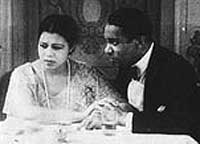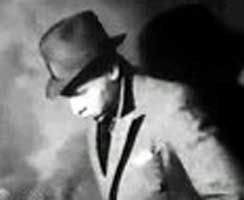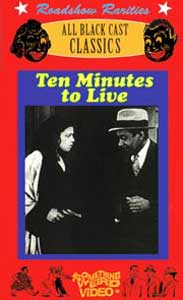The confused gangster film Ten Minutes to Live (1932) has an all black cast, not counting a few white (if not merely lighter than yaller) chorus girls in a couple dance numbers. Oscar Micheaux was the first African American producer & director to create sound feature films. His company's product had to be done very cheaply because the only outlets were black neighborhood cinemas in major cities, a guaranteed but restricted distribution.
 As a sound feature, Micheaux used every trick in the book to save money, including long silent film stretches with a few sound effects instead of dialogue, to make it seem like every reel is a talkie. The most overused method of moving the story forward is to have characters' written messages put up on the screen. As a sound feature, Micheaux used every trick in the book to save money, including long silent film stretches with a few sound effects instead of dialogue, to make it seem like every reel is a talkie. The most overused method of moving the story forward is to have characters' written messages put up on the screen.
When dialog is recorded, typically two characters will lean their heads over a restaurant table & speak very clearly & woodenly into the hidden microphone. In another sequence all the dialog is being overheard through a door, so no synchronized sound had to match the characters speaking.
Micheaux has sometimes been called "the Black Ed Wood" but given the difficulties of any independent filmmaker in the 1930s, Micheaux deserves straight-up admiration. Completely self-taught, with no industry support, having always to be mightily clever to get the most out of every dollar (& during the Depression to boot), it's remarkable that he did it as well as he did.
He attempted to present images of black people more varied & better than those from the white film industry. He still dealt with storytelling cliches & standardized entertainment, but he was no political naif, he knew that the Hollywood take on black folks in no way reflected black people, neighborhoods, or culture, & he actively strove to redress this lack.
 The characters of the crime tale are fairly dignified, & women are among the strongest characters. Abominable acting & ultra-cheapo production tends to disguise the filmmaker's strengths in his clear desire to uplift African Americans with proud screen images of black folk as more than maids, porters, & skeert comic relief. The characters of the crime tale are fairly dignified, & women are among the strongest characters. Abominable acting & ultra-cheapo production tends to disguise the filmmaker's strengths in his clear desire to uplift African Americans with proud screen images of black folk as more than maids, porters, & skeert comic relief.
When Hollywood saw that black neighborhood theaters could be profitable, independent black-owned companies were squeezed out of business by white-directed all-black-cast films, except for Micheaux who survived beyond the 1930s. And his use of the nightclub sequence became a Hollywood standard, too, so that Micheaux's influence was permanent. In consequence, some of the leading black acts of the day can still be seen because of just such Harlem nightclub interludes.
Micheaux's extended floorshow is where most of his miniscule budget for sound went. This showcases authentic Harlem nightclub acts of the time. When we see in Ten Minutes to Live two black Vaudevillian comics performing in blackface, it's because black comedians of that era really did rub burnt cork on their faces as a holdover from travelling minstrelry.
The chorus girls who're especially talented had to complete their line-routines in front of a stationary camera in an extremely tight space. How Micheaux framed the acts, & how the acts squeezed close yet managed not to whack into each other during rapid dance routines, took both talent & cleverness.
Viewers with zero interest in film history or black history are not apt to enjoy this for the gangster story which is hard to follow & woodenly performed. But it is a great joy to see if any aspect of the Harlem Renaissance has ever been of interest.
copyright © by Paghat the Ratgirl
|

 As a sound feature, Micheaux used every trick in the book to save money, including long silent film stretches with a few sound effects instead of dialogue, to make it seem like every reel is a talkie. The most overused method of moving the story forward is to have characters' written messages put up on the screen.
As a sound feature, Micheaux used every trick in the book to save money, including long silent film stretches with a few sound effects instead of dialogue, to make it seem like every reel is a talkie. The most overused method of moving the story forward is to have characters' written messages put up on the screen. The characters of the crime tale are fairly dignified, & women are among the strongest characters. Abominable acting & ultra-cheapo production tends to disguise the filmmaker's strengths in his clear desire to uplift African Americans with proud screen images of black folk as more than maids, porters, & skeert comic relief.
The characters of the crime tale are fairly dignified, & women are among the strongest characters. Abominable acting & ultra-cheapo production tends to disguise the filmmaker's strengths in his clear desire to uplift African Americans with proud screen images of black folk as more than maids, porters, & skeert comic relief.